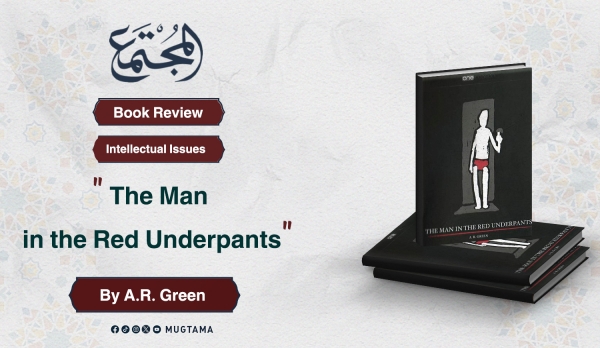Book Review: “The Man in the Red Underpants” By A.R. Green
About the Author
A.R. Green is a British author and speaker known for his engaging writings on Islam and comparative religion. Formerly a Christian, he embraced Islam after deep study and reflection. He has delivered lectures worldwide on Islamic teachings and spiritual development. His works often focus on making Islamic concepts accessible to a modern audience.
Chapter 1: "The Journey Begins"
In the opening chapter, A.R. Green challenges the reader to confront life's biggest and most avoided questions—death, the meaning of life, and the existence of Allah. Through a blend of informal tone and philosophical reasoning, the chapter introduces the metaphor of "the man in the red underpants" to explore how humans use logic and common sense in daily life, yet often abandon them when considering the origin of the universe. Using examples like mobile phones and fine-tuning in cosmology, Green argues that the complexity and order of the universe point towards intelligent design rather than random chance. He invites the reader to embark on a journey of reason, urging them to examine life with honesty and rationality, laying the foundation for a deeper exploration of belief and purpose in the chapters to come.
Chapter 2: "Unanswered Questions"
Addressing suffering, life’s purpose, and the afterlife, this chapter asserts that while reason alone cannot answer these questions, a benevolent Creator would provide guidance, just as physical needs are met. The author compares religions to strangers claiming to read a gas meter, stressing that trust requires verification—not blind faith, cultural inheritance, or emotional appeals. Critiquing flawed justifications for belief (e.g., tradition or personal happiness), the chapter emphasizes that true religion must offer objective proof of divine origin, preparing readers for further tests of authenticity.
Chapter 3: "The Test of Teachings"
In this chapter, A.R. Green presents a rational test to assess religious teachings by examining their conception of the Creator. He argues that a valid belief system must affirm the existence of a One, Eternal, Unique, and Self-Sufficient Creator, distinct from creation. Based on this test, he contends that only Islam, Judaism, and Zoroastrianism meet this standard, while religions like Hinduism, Christianity, Buddhism, and Sikhism fail due to theological contradictions or lack of divine origin. Green criticizes the notion of a god incarnate or anthropomorphic deity as irrational and inconsistent with the concept of a transcendent Creator. The chapter ends by suggesting the need for further criteria to continue evaluating religions.
Chapter 4: "The Test of Universality"
In this chapter, A.R. Green explores the idea that a true divine message must be universal—accessible and relevant to all of humanity, regardless of race, nationality, or background. He critiques Judaism for being exclusive to a specific lineage and highlights Islam’s claim of universality. Green argues that Islam uniquely offers a rational, intuitive, and inclusive belief system that aligns with the natural disposition (fitrah) of all people. He emphasizes that Islam is not tied to ethnicity or geography but is based on the idea of submitting to the Creator—an idea that can be reached through reason alone, making it a viable path for anyone, anywhere.
Chapter 5: "The Test of Character"
This chapter scrutinizes Prophet Muhammad’s sincerity and the Quran’s preservation as evidence of Islam’s divine origin. Unlike fragmented scriptures, the Quran’s textual consistency—unchanged for centuries—is highlighted. Muhammad’s life, marked by truthfulness and conviction, defies accusations of deceit or madness. The Quran’s literary brilliance, historical accuracy, and scientific foresight (e.g., embryology) are inexplicable without divine intervention, solidifying Islam’s claim as the True Religion. "Had it been from other than Allah, they would surely have found therein contradictions in abundance." (Surah An-Nisa, 4:82).
Chapter 6: "Amazing Level of Information"
The Quran’s scientific and historical precision—unknowable in 7th-century Arabia—is proof of divine authorship. Examples include correct distinctions between Egyptian rulers (King vs. Pharaoh), Haman’s role in ancient Egypt, the Big Bang, embryonic development, and mountain roots stabilizing Earth’s crust. The chapter argues these details, aligning with modern discoveries, defy human explanation, reinforcing the Quran’s status as revelation.
Chapter 7: "Teachings of the Book"
Outlining Islam’s core tenets, the chapter emphasizes monotheism, life as a test of free will, and the Five Pillars (prayer, charity, fasting, etc.). Moral imperatives—truthfulness, justice, kindness—are tied to eternal consequences: paradise for the righteous, hell for the rebellious. Structured worship and ethical living are paths to inner peace, with life framed as a temporary trial for divine judgment.
Chapter 8: "The Journey’s End"
In the final chapter, Green brings the journey full circle by inviting the reader to act on the truth they've explored. He encourages taking the first step towards embracing Islam by sincerely turning to the Creator and asking for guidance. Green also emphasizes that while accepting the message may seem daunting—especially due to social or cultural concerns—acting upon it is simpler than it seems.
He outlines the core step to becoming a Muslim: testifying that there is no god but Allah and that Muhammad is His Messenger. Practical next steps like learning to pray are mentioned, along with a resource for support (Muslim Now). He closes the chapter with a heartfelt prayer for peace and blessings, encouraging readers to move forward with conviction.
